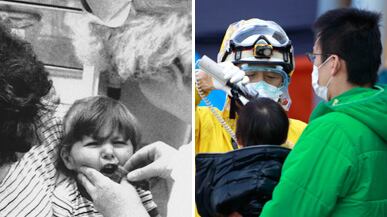Despite the scary race to prevent two meltdowns in Japan, the man who led the Chernobyl response explains how advances in nuclear design and the swift response will prevent any damage along the lines of 1986 Soviet disaster. Plus, Josh Dzieza talks to a nuclear scientist about how bad the situation could get.
The partial meltdown of Reactor 3 at the Fukushima Daiichi power station is the most serious nuclear accident since Chernobyl, but Russian experts say the differences mercifully outweigh the similarities.
Indeed it may be thanks in part to the terrible legacy of the April 1986 disaster that Fukushima's meltdown can be contained. "The accident at Fukushima shows that experts around the world drew some important lessons from what happened at Chernobyl," said nuclear engineer Ilgiz Iskhatov, who was decorated for his role in containing the fallout of the Chernobyl blast. "Now nuclear power-station designs and safety systems are capable of withstanding much more serious accidents [than Chernobyl]."

The meltdown of the Chernobyl reactor blew the unit's casing apart and voided the core to the atmosphere. Fukushima hasn't yet melted through the reactor vessel, thanks to engineers pumping seawater into the cooling systems.
"There is no question of a Chernobyl situation or of anything like the same threat to human health and safety," Rafael Arutyunyan, deputy head of the Russian Academy of Sciences' Institute of Nuclear Energy Development Security, told Russian NTV News. "An accident like Chernobyl cannot happen again—this is a reactor of a different generation. Even in the worst-case scenario of a total coolant failure, the radiation released will be hundreds of times less than from Chernobyl."
Just as important, said Iskhatov, the Japanese authorities have "acted quickly and effectively to communicate with the local residents—they don't treat their population like idiots like ours did."
In the immediate aftermath of the Chernobyl blast, Soviet authorities tried to hush up the accident, and the world was alerted to the deadly cloud of nuclear fallout traveling across Northern Europe when radiation alarms went off at the Forsmark nuclear power station in Sweden, more than 1,000 kilometers north of the accident site. Evacuation of the Chernobyl area did not begin until 24 hours after the initial accident, which killed 54 people directly and as many as 4,000 from radiation-related illnesses. In Japan, within hours of the initial alert, Japanese authorities evacuated 200,000 people from the area of Fukushima. Russia has also sent two teams of emergency rescue specialists to Japan and promised extra deliveries of natural gas, though no Russian nuclear experts have been requested or sent.
According to a detailed Soviet report released to the public after the fall of communism, the Chernobyl blast was caused by a sudden, catastrophic spike in temperature at the reactor that caused cooling graphite rods to shatter, which in turn allowed a runaway nuclear reaction that within three seconds produced more than a hundred times the unit's usual heat output. The coolant from burst pipes flashed into steam, blowing a 2,000-ton steel and concrete lid off the reactor core and spreading radiation across the Soviet Union and Europe.
"Chernobyl taught the world of nuclear reactor designers that they have to be ready for the most unforeseen failures, the most extreme situations," said Iskhatov.
• Josh Dzieza: How Bad Could It Get?• Eleanor Clift: Richard Thornburgh’s Advice for Japan• 10 Worst Nuclear Disasters• Photos, Videos of the Crisis Mercifully, the accident at Fukushima seems to be far less serious. Japanese Prime Minister Naoto Kan said Sunday the nuclear crisis in the northeast of the country was "fundamentally different from the Chernobyl accident"—and he seems to be right, unlike the Soviet authorities in 1986 who did everything to downplay and deny the seriousness of Chernobyl. According to initial reports, two separate reactors at Fukushima were put out of action by the earthquake: Reactor 1, which suffered an explosion in the turbine hall causing a small escape of radiation, and Reactor 3, which appears to have partially melted down after a power failure to both its main and backup cooling systems. On Sunday night, Japanese technicians were still trying to bring the two under control; cooling stations at two of three reactors at the neighboring Daini power station had been restored.
"What's happening now is more akin to the reactor accident at Three Mile Island in Pennsylvania in 1979 than Chernobyl," blogged Aleksandr Uvarov, editor of the Moscow-based web portal AtomInfo-Center. At Three Mile Island, a coolant failure led to a partial reactor core meltdown—though like in Fukushima, the casing of the Three Mile Island reactor wasn't breached, unlike the catastrophic explosion that blew apart Chernobyl.
Japanese Chief Cabinet Secretary Yukio Edano confirmed Sunday to reporters that a partial meltdown in Reactor 3 is "highly possible," and the presence of radioactive cesium in leaked radiation suggests that fuel rods have already melted, according to U.S. nuclear physicist Ken Bergeron. "The containment building at this plant is certainly stronger than that at Chernobyl but a lot less strong than at Three Mile Island, so time will tell," he said.
Fukushima is avoiding total meltdown so far—but pumping in seawater is "an act of desperation," Robert Alvarez of Washington's Institute for Policy Studies told a press conference Saturday. "I would describe this measure as a 'Hail Mary' pass"—a last-ditch attempt to save a desperate situation. Still, had it not been for the lessons learned from Chernobyl, the disaster could have been far worse. "Chernobyl taught the world of nuclear-reactor designers that they have to be ready for the most unforeseen failures, the most extreme situations," said Iskhatov.






